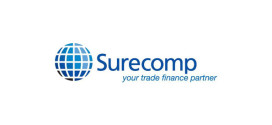
General IFSB and Emad Al Monayea, CEO, KFH Investment
Mushtak Parker looks at a slight slackening of Sukuk activity and raises some question as to what might be behind it given the flurry of issuances that occurred in the first five months of this year
A wash with a surfeit of liquidity in the two key regional markets of the Gulf Cooperation Council (GCC) countries and South East Asia, especially Malaysia and Indonesia, and with the tough capital and liquidity requirements for financial services institutions under the new Basel III Concordat driving banks into more direct investments, is the global Sukuk market losing its gloss?
Judging by the flurry of activities in the Sukuk market in the first five months of 2015, the market certainly seems to have maintained its sustainability, albeit its buoyancy is not as pronounced as for the same period in the last two years.
Perhaps the slowdown was partly due to the onset of Ramadan in the third week of June, when business and finance traditionally slows down dramatically especially in the GCC countries, and equally traditionally sees a hike in the months immediately after the Hajj, the Muslim pilgrimage, which is just over a month after the end of Ramadan. Or are there other forces at work contributing to this perceived slowdown?
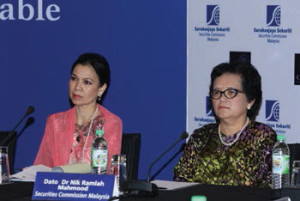 The figures are implicit. According to Dr Nik Ramlah Mahmood, the deputy chief executive officer of the Securities Commission Malaysia (SC), the securities regulator, global Sukuk issuance for first quarter 2015 totalled $19bn, compared with $24bn for the same period in 2014.
The figures are implicit. According to Dr Nik Ramlah Mahmood, the deputy chief executive officer of the Securities Commission Malaysia (SC), the securities regulator, global Sukuk issuance for first quarter 2015 totalled $19bn, compared with $24bn for the same period in 2014.
However, the projections of international credit rating agency Standard & Poor (S&P) are even more depressed. Dr Mohamed Damak, director, global head of Islamic finance at S&P, projects that “the total Sukuk issuance is likely to drop significantly on the back of lower issuance from central banks that have switched to other shorter liquidity management instruments”.
According to S&P, total Sukuk issuance for the year ending 31 May 2015 amounted to $33.7bn compared with $50.5bn for the same period in the previous year.
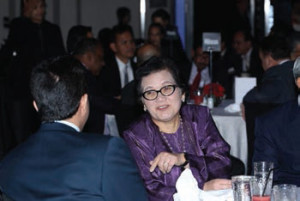 Perhaps expectations have been unrealistic for a nascent Islamic finance industry with a contemporary market history of a mere four decades and a Sukuk origination history of just two decades. In reality, according to the Islamic Financial Services Board (IFSB), the prudential and supervisory standard setting body for the international Islamic financial services industry, the total global Sukuk market constitutes a mere 0.25 per cent of the global bond market.
Perhaps expectations have been unrealistic for a nascent Islamic finance industry with a contemporary market history of a mere four decades and a Sukuk origination history of just two decades. In reality, according to the Islamic Financial Services Board (IFSB), the prudential and supervisory standard setting body for the international Islamic financial services industry, the total global Sukuk market constitutes a mere 0.25 per cent of the global bond market.
Perhaps the market has been taking a too short-term view on Sukuk issuance, which has partly been clouded by the exuberance of the record total primary Sukuk offerings of $137.2bn in 2012 – a riposte to the $39.6bn in 2007 just prior to the onset of the global financial crisis in 2008, thus signalling the market’s recovery in the aftermath of the economic impact of global financial crisis.
In addition, the capacity to mobilise funds has also increased tremendously, with over $500bn raised through Sukuk issuances in the five years following the financial crisis (2009–2013), in contrast with just US$92bn raised in the five years before (2002-2006).
Perhaps the figures for the subsequent three years – $119.71bn in 2013; $118.8bn in 2014; and an estimated $125bn for 2015 suggest a long overdue market correction. In 2014, 66 per cent of global Sukuk issuance was from Malaysia, the single largest global Sukuk origination domicile.
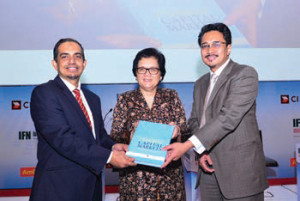
(middle) at the launch of the publication ‘Islamic Capital Markets: Principles
and Practices” with Prof Akram Laldin, CEO of The International Shari’ah
Research Academy for Islamic Finance (ISRA) (left) and Mohd Izani Ghani,
Chief Financial Officer, Khazanah Nasional Berhad (right).
Nevertheless, the compound annual growth rate (CAGR) of the Sukuk market has increased to 20 per cent, according to the SC.
At best, these figures suggest the sustainability of the Sukuk sector above the $100bn mark for the last four years. But to take that great leap forward for the Sukuk market to make a meaningful impact, it needs to have a critical mass of primary issuances upwards from a minimum volume of at least $500bn a year for the global financial, corporate and public entities to really take Sukuk as an alternative fund raising instrument seriously.
Not surprisingly, the consensus from market players attending the London Sukuk Summit in June was clear but pragmatic: “We need more of the same – more Sukuk issuances, both sovereign and corporate; of varying sizes and maturities; diversified and innovative structures as long as we do not compromise Shariah principles.”
The rationale is that continued proliferation of issuances will eventually lead to much-needed market depth and critical mass of Sukuk offerings, which in turn could attract potential market makers to precipitate an active worldwide secondary trading, which currently is almost exclusively confined to Malaysia, with the Malaysian Sukuk market remaining the only jurisdiction with an outstanding volume in excess of $100 billion. Total Sukuk outstanding as at end 2014 amounted to $301bn, of which Malaysia accounted for 57 per cent.
The IFSB, in its Islamic Financial Services Industry Stability Report for 2015, which was released at its 12th annual summit in Almaty, Kazakhstan, at the end of May, concurs that “a pressing challenge that impacts the sustainable growth and development of the Sukuk market as a mainstream fund-raising component of the global capital markets is the lack of liquid and active secondary Sukuk markets in key Islamic finance domiciles, which limits investors’ ability to trade Sukuk instruments”.
This impacts on other challenges, including the lack of appropriate benchmarks to gauge the correct levels of yields on outstanding instruments. “Often Sukuk certificates are benchmarked against the conventional instruments (bonds), adding a few basis points (bps) as premiums over and above the conventional yields. For this reason, Sukuk instruments are often priced at a premium, costing issuers anywhere between 5bps to as much as 50bps more than the issuing conventional bond instruments,” explained the IFSB Report.
The lack of an active secondary market for Sukuk is largely due to a lack of supply of tradable Sukuk thus prompting investors to hold the certificates on to maturity. This is further exacerbated by the dearth of other Shariah-compliant investment instruments, which offer comparative yields higher than cash and similar instruments (such as commodity Murabaha or Tawarruq), which in turn offer unattractive returns in a market impacted by a generally depressed and low interest rate conventional financial environment.
As such, does the holding on to certificates till maturity per se compromise the ethical utility of the market trading process in addition to stifling the unlocking of much-needed liquidity in the market?
The holding on to Sukuk certificates for normal market and investments reasons such as the above does not contravene Shariah principles. According to Dr Daud Bakar, executive chairman of Amanie Advisors, one of the prominent Shariah advisories in the global Islamic banking industry, who is based in Dubai and Kuala Lumpur, holding on to Sukuk certificates till maturity for legitimate market reasons does not constitute hoarding, which is proscribed in Islam, and which usually pertains to commodities, equipment and essential foodstuffs.
However, holding on to certificates to manipulate and undermine the market intentionally would be contrary to Shariah investment principles.
In addition, according to the IFSB, differing opinions of Shariah advisories on Sukuk tradability; and a general lack of understanding of such instruments, have led to a limited universe of investors’ base.
The good news is that a number of multilaterals and regulatory bodies including the IFSB, the Bahrain-based International Islamic Financial Market (IIFM) and the Accounting and Auditing Organisation for Islamic Financial Institutions (AAOIFI) have issued a number of standards that support the harmonisation of Sukuk structures in cross-border markets while providing guidelines for structuring instruments that are tradable while meeting Shariah requirements. These are essential steps towards achieving liquid and active domestic and cross-border secondary Sukuk markets.
Diversification of investors’ base is already becoming a reality. According to S&P’s Dr Damak, international Sukuk issuance is increasingly driven by higher appetite from both traditional/non-traditional issuers to tap the Sukuk investors’ base and lower central banks’ issuance due to the latter’s switching to other liquidity management instruments and because of the impact of lower oil prices.
The emerging trend of the investor profile for international Sukuk issuances in the last year constitutes five distinct investor bases – Middle East (mainly GCC and Turkey); Asia (mainly Malaysia, Singapore and Hong Kong); Europe (UK, Germany, Switzerland, France); US (offshore pension and other institutional accounts); local domestic institutional investors.
For instance, the 5-Year $1 billion Reg S Sukuk Wakalah issued at the end of May by the Government of the Hong Kong Special Administrative Region of the People’s Republic of China (the HKSAR Government) – its second Sukuk offering in a space of eight months under its Government Bond Programme – comprised a 43 per cent allocation to Asian investors, 42 per cent to Middle Eastern investors and 15 per cent to European investors. In contrast, both the $500m debut Sukuk of Goldman Sachs and the $500m Sukuk by the International Finance Facility for Immunisation Co. (IFFI) of the World Bank, were overwhelmingly subscribed by investors from the Middle East – 87 per cent and 68 per cent respectively.
However, in terms of investors’ base diversification the tables were completely turned with the subscription to the $930m Sukuk issued by Emirates Airlines in March 2015, the proceeds of which are being used to fund the acquisition of four Airbus A380-800 aircraft. The aircraft will be leased to and operated by Emirates.
The Sukuk has the potential of becoming a game changer in the way airline fleet acquisitions are financed in the future especially by airlines in the Middle East and North Africa (MENA) region, South East Asia and even Europe and beyond. The Sukuk issuance is guaranteed by UK Export Finance (UKEF), formerly the Export Credit Guarantee Department (ECGD), the official export credit agency (ECA) of the British Government.
In a statement, Emirates Airlines explained that the Sukuk “marks the world’s first Sukuk financing facility supported by UKEF and the largest ever capital markets offering in the aviation space with an Export Credit Agency guarantee”. The transaction also marked the first time that a Sukuk has been used to pre-fund the acquisition of aircraft and the first ever Sukuk financing for A380 aircraft.
The revealing aspect of the investor allocation is that 61 per cent of the subscription was by non-Muslim investors – 32 per cent from Europe and 29 per cent from the US. It is not clear whether the non-Muslim investors were attracted primarily by the higher yield on Sukuk per se or by the fact that the offering carried a credit enhancement guarantee wrap of the UK government.
According to S&P’s Dr Damak, it is not always true that foreign investors buy Sukuk for their higher yield. On average, investors had eight bps additional yield when they invested in the Dubai Sukuk versus Dubai bonds for the past couple of years. It was the same for investors in Indonesia Sukuk versus Indonesia bonds for the past couple of years, who had an additional yield of 22bps.
However, the Pakistan sovereign Sukuk yielded almost exactly the same yield compared with a similar conventional bond of Pakistan. But the sovereign Sukuk issued by Qatar yielded 11bps less than a comparable Qatar conventional bond on average for the past two years.
Nevertheless, S&P expectations for the Sukuk market going forward are ambiguous. On the upside, economic conditions in core Sukuk markets are expected to remain good especially in the GCC, Turkey, Malaysia and Indonesia. There are several “new potential issuers” looking for potential issuances in 2015.
At the same time, the impact of the provisions and implementation of the Basel III Concordat especially relating to high quality liquid assets (HQLA), of which there is a dire lack of in the Islamic finance space, may drive-up Sukuk issuances from government, central banks, government-linked companies, albeit this would be more in the medium term.
The downside, in contrast, is the lower oil price and its impact on government sponsored projects and liquidity in core markets.
The global markets are also anticipating the much-vaunted increase in the interest rate in the US by the Federal Reserve and its impact on global liquidity not only in the conventional bond sector but also its knock-on effect in the Sukuk market.
In fact, according to S&P, there is already evidence of lower liquidity in banking systems resulting in lower Sukuk issuance by central banks.
Market experts such as Emad Al Monayea, CEO of KFH Investment, a subsidiary of Kuwait Finance House (KFH), concur that investor appetite for Sukuk in the GCC is still very hot.
There is growing competition between GCC banks, especially the conventional ones, for investment avenues, some of which are providing more and more commitments just to win Sukuk mandates. There is also more interest in international papers because nvestors are seeking portfolio diversification as there has been over-concentration on investing in local papers.
According to Al Monayea, there also remains a huge amount of excess liquidity in the GCC, where the beginnings of a nascent secondary trading market within GCC banks is also bring promoted by assets managers.
The liquidity argument and the competition for origination are not confined to the GCC. The Malaysia International Islamic Financial Centre (MIFC), for instance, has been remarkably successful over the last two years in attracting companies from the Middle East and North Africa (MENA) in raising funds through Sukuk issuances in the ringgit market.
The latest MENA bank to do so is Kuveyt Turk Participation Bank (KTPB), the Turkish subsidiary of KFH, which issued a RM300m Sukuk Wakala bi Al-Istithmar, in April, the first tranche under its newly-launched RM2bn Ten-Year Islamic Medium Term Notes (Sukuk Wakala) Programme. Abu Dhabi Islamic Bank (ADIB) similarly is finalising its Sukuk issuance in the ringgit market.
“The reason why we started issuing ringgit Sukuk is mainly the cost advantage,” explained Ufuk Uyan, chief executive officer of KTPB, in an interview. “To give you an example even though we are among the best-rated borrowers in the Participation Banking sector in Turkey, we raised our US$500m Five-Year Sukuk last year with an all in all cost of 5.175 per cent per annum. In contrast, when we raised funds from the ringgit market with 5.9 per cent and 5.8 per cent on a ringgit basis and after swapping, all in all the cost of Sukuk origination in Malaysia is around 4.4 per cent on a US dollar basis.”
Several MENA issuers in the ringgit market concur that for the moment the MIFC platform is a compelling reason for origination. Thus far Mumtalakat Holdings (the Bahrain sovereign wealth fund), Abu Dhabi Commercial Bank, Gulf International Bank, Gulf Investment Corporation, Al Bayan Saudi Arabia, The Islamic Development Bank, and Turkiye Finans, the Turkish subsidiary of National Commercial Bank of Saudi Arabia, have all issued ringgit denominated Sukuk in the Malaysian market.
However, Emad Al Monayea’s two biggest concerns are that the provisions of Basel III with its listing and trading requirements may be driving existing and potential investors away from Sukuk as an investment asset class into less complex direct investments.
Sukuk features for the first time in a Standard issued under The Basel III Concordat, which is a cornerstone of resilience through its new capital and liquidity frameworks. The liquidity framework has refined the concept of High Quality Liquid Assets (HQLA) and introduced two standards, the Liquidity Coverage Ratio (LCR) and Net Stable Funding Ratio (NSFR), amongst others, to bolster this framework. The LCR came into effect in 2014 but is to be phased in by 2019.
With the active engagement of the IFSB, the Basel Committee has decreed that certain type of Sukuk can qualify to be included as HQLA. Islamic banks are not likely to find it overly challenging to comply with the enhanced capital requirements coming out of Basel III, though they might find meeting the enhanced liquidity requirements relatively more challenging.
In April, the IFSB adopted a new Guidance Note on Quantitative Measures for Liquidity Risk Management in Institutions Offering Islamic Financial Services (GN-6), which aims to complement the LCR and NSFR Standards of Basel III and other developments on liquidity risk management for the Islamic financial services industry (IFSI). “It will help the regulatory and supervisory authorities to provide a level-playing field to the Islamic finance industry in the application of liquidity standards vis-a-vis their conventional counterparts, and thus will promote the sound management of liquidity risk in the industry,” said an IFSB statement.
“The ultimate objective of all Islamic banks is to be in compliance with Basel III requirements. Does Basel III distinguish between Islamic and conventional banking? No. It is constructed on the basis to serve the conventional banking industry. I, as an Islamic investment bank, am using a conventional framework,” explained Almonayea in an interview.
He commends the work of the IFSB but rues the fact that many of the IFSB standards and guidance notes have not been adopted and implemented by most jurisdictions where Islamic finance is available.
“Why do our regulators not adopt the IFSB standards, even if they lag behind the conventional ones? Islamic banks have to be in compliance with IFSB standards otherwise what is the need for the board. We need to have mandatory adoption of IFSB standards. It is the one organisation that understands the specificities of Islamic finance, especially its special characteristics, and speaks the same language,” he added.
He is also concerned about the Shariah compliance and governance of some Sukuk structures. Take for instance the $1bn Sukuk Wakalah issued by the HKSAR in May.
“The Sukuk issuance is structured as a Sukuk Wakalah, a globally accepted Islamic structure with an asset light feature. This is the Government of Hong Kong’s first issuance of Sukuk Wakalah, whereby the Issuer shall use no less than 34 per cent of the Sukuk proceeds to purchase selected units in government-owned properties and no more than 66 per cent of the Sukuk proceeds to purchase Shariah-compliant commodities. This structure is highly innovative, allowing the Government of Hong Kong to raise Shariah-compliant financing in an asset efficient manner,” emphasised one of the lead managers involved in the transaction.
The use of the phrase “asset light” is unfortunate and is already creating confusion and dissent in the Sukuk market. The phrase has conjured up other cynical terminologies such as “Sukuk light” and “Shariah light,” which only serve the agenda of the detractors of Islamic finance.
Al Monayea defends his concerns about the HKSAR Wakalah Sukuk. “I am not detracted by the use of asset light or Sukuk light. You will be surprised what goes on behind the closed doors. Give a non-Muslim issuer a Wakalah structure, but what does it mean? Wakalah has to be given to a Shariah-compliant Wakeel (agent). Are these institutions and issuers Shariah-compliant Wakeels? No. This is worrying us,” he explained.
The true misunderstanding, in reality, stems from a misconception about the asset mix in the Wakalah structure as in others. The convention hitherto has been that as long as the tangible assets such as real estate, land, and buildings comprised 51 per cent or more of the mix, the remaining could comprise intangible assets such as Murabaha and other trade receivables.
However, according to Amanie Advisors Dr Daud Bakar, who sits on several Shariah boards of financial institutions both in the MENA region and in South East Asia and is the chairman of the Shariah Advisory Council (SAC) of Bank Negara Malaysia (the central bank), there is no basis in the Shariah for the above 51:49 split in the asset pool mix.
In London in June at the Sukuk Summit, Dr Bakar emphasised that Shariah “is all about fulfilling the needs of society without breaching the Divine limits. Shariah governance involves the substantive rulings and processes, but while there could be a degree of flexibility in substantive ruling, strict adherence to the required process is a must. The visibility of Shariah assurance is central to all innovative Sukuk structures and products”.
Indeed, Dr Daud has been at the forefront in innovating new Sukuk structures in recent times. These include Hybrid Sukuk, Project Sukuk, Convertible and Exchangeable Sukuk, “Warehouse” based Sukuk, Value chain-based Sukuk, Retail Sukuk, Sukuk and its synergy to tax regimes and inflation, and Socially Responsible (SRI and Green Sukuk).
Given the above caveats, the immediate future activity in the Sukuk market seems well-founded.
Sovereign issuances – both global and domestic offerings – continue to flourish with Malaysia, Indonesia, Ras Al Khaimah, Sharjah and Turkey being repeat issuers in 2015. Luxembourg is on record working on its second sovereign Sukuk foray, with Kazakhstan, Oman, Malta, Jordan, Senegal and Morocco already issuing mandates or expressions of interest for either debut or repeat issuances.
Several market players are eying North Africa and Africa in general, with Nigeria, Kenya, South Africa and primarily Morocco the main markets. Bankers are especially pleased with the new Moroccan Islamic Banking Code, which is very comprehensive.
“I expect Morocco to issue a benchmark Sukuk. I have had the chance to discuss this with the various officials. They are thinking of it. The question is will they mandate French banks or Islamic banks to help them structure and arrange their debut issuance. I suggested that they hire both – the French banks bringing their vast capital market experience and distribution reach, and the Islamic banks their Shariah and Sukuk experience,” explained Emad Al Monayea. Another market player who advises the Moroccan authorities also confirmed an imminent debut Sukuk by Rabat sometime later this year.
A conspicuous absentee from the sovereign Sukuk and for that matter corporate Sukuk market is Kuwait, Al Monayea’s home country. “It is imperative that the government and the Central bank of Kuwait benchmark originators of Sukuk. It is only a matter of time. We have five local and one regional Islamic bank authorised in Kuwait. The regulators have to have the liquidity management tools to activate their regulatory and supervisory requirements. It has become a must because of market need, credit need and a need to fund government expenditure. Yes, oil prices are lower. Yes, we have a good amount of reserves.
“But my advice is to keep your cash reserves and to utilise them only in an emergency. It will support Kuwait’s creditworthiness to say that the government is not desperate. We need to save our cash for the future. Many mega projects are beckoning in Kuwait especially in infrastructure and in the vital oil and gas sectors,” he contends.
New domestic sovereign Sukuk issuers include the Bank of Bangladesh (the central bank) and the National Treasury is also working on its first rand-denominated Sukuk.
The demand for short-term Shariah-compliant international liquidity management instruments by Islamic banks the world over cannot be understated. These are facilitated either through local currency Sukuk issuances by central banks or Government Debt Management Offices or Shariah-compliant repo arrangements based on commodity Murabaha.
The International Islamic Liquidity Management Corporation (IILM) was specifically established in 2011 as a multilateral institution to facilitate the above through short-term US dollar denominated Sukuk issuance, which are backed by a minimum single A rated sovereign assets, which in turn underpins the credit quality of the underlying asset pool. Thus far IILM Sukuk outstanding is $1.85bn, and since its first issuance in 2013, a total of $9.98bn Sukuk have been issued and reissued by IILM after auctions.
Short of nurturing a culture of dependency for such short-term issuances, experts agree that the work of the IILM alone is not enough to address the liquidity management challenge the industry is faced with. The market needs more products and arrangements in the area of liquidity management to ensure that the growth of the Islamic finance industry can weather the regulatory and economic challenges of the future.
The tried and tested issuer by far in the global Sukuk market is the Islamic Development Bank (IDB) Group, which is very committed to the continued development of the market. The IDB closed its latest issuance in March – a US$1bn Sukuk under its $10bn Islamic Trust Certificate Issuance Programme.
However, it is another IDB affiliate that is setting the pace especially in helping sovereigns in emerging countries to issue Sukuk. The Islamic Corporation for the Development of the Private Sector (ICD), the private sector funding arm of the Jeddah-based Islamic Development Bank (IDB) Group, has been mandated by Cote d’Ivoire and Niger to help structure and arrange debut Sukuk. ICD last year played a similar role in helping Senegal to issue its debut Sukuk. At the same time, ICD has also got a mandate from Jordan and Tunisia to help these two countries to bring their debut Sukuk to the market.
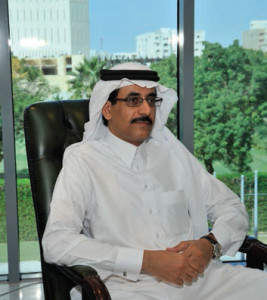
“On the Cote d’Ivoire and Niger Sukuk we are currently working on finalising the structure and technical aspects of Sukuk issuance. Once we are finished, we will then present it to the two respective governments for consideration. I expect things to go well,” explained Khaled Al Aboodi, CEO of ICD.
Al Aboodi also revealed in an interview that the ICD itself plans to issue a Sukuk later this year following approval from its Board to raise $1.2bn in resources from the market. “This will be in the form of Sukuk and bridge financing. We plan to issue a Sukuk with a tenor of five years in the third quarter of 2015. We have not decided on the size. This will be the first time that an affiliate of the IDB Group will issue a separate Sukuk. The ICD needs to do this because we require long-term financing to fund our projects and activities,” he added.
Another encouraging sign is the continued buoyancy of the two biggest Sukuk markets – Malaysia and Saudi Arabia. In Saudi Arabia new entrants include Najran Cement and Bahri (National Shipping Company). This is complemented by such issuers in other markets, including Noor Bank in the UAE, Indosat in Indonesia and K Electric in Pakistan.
Repeat issuers include Dubai Islamic Bank (DIB) with its second Sukuk in 2015 – a $750m 5-year issuance in June to complement its $1bn Tier I Regulation S Perpetual Sukuk issuance in January this year. Similarly, the Saudi British Bank is the latest conventional bank to issue a Sukuk to support the Bank’s capital base in light of the Basel III framework and to fund its growth. The 10-year SR1.5bn subordinated Tier II Sukuk Wakalah was closed at the end of May through a private placement.
Another market segment that has seen a flurry of Islamic finance activity is the aviation sector. Following on from the Emirates Sukuk in April, the Indonesian national carrier Garuda issued a $500m Sukuk Wakalah in May thus becoming the first Asia Pacific national flag to close a US dollar benchmark bond/Sukuk successfully on a standalone basis since the one issued by Qantas way back in 2006.
The Sukuk issuance as such carries no credit enhancement in the form of a guarantee either from a government agency or financial institution.
Perhaps the most socially edifying Sukuk is the RM300m SRI Sukuk issued in May by Khazanah Nasional Berhad, the Malaysian sovereign wealth fund, via a Malaysian-incorporated independent special purpose vehicle, Ihsan Sukuk Bhd, under its RM1bn Sukuk programme. The RM300m issuance is the first tranche under the programme and the first such Sukuk approved under the SC’s Sustainable and Responsible Investment (SRI) Sukuk framework.
The proceeds of this Sukuk, according to Khazanah, will be channeled to Yayasan AMIR, a non-profit organisation initiated by Khazanah in 2010, to manage its cashflow for the deployment of its Trust Schools Programme under its financial and social inclusion initiative. n
 Cash And Trade Magazine For Cash and Trade professionals in the Middle East
Cash And Trade Magazine For Cash and Trade professionals in the Middle East




